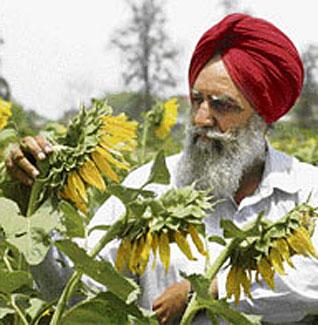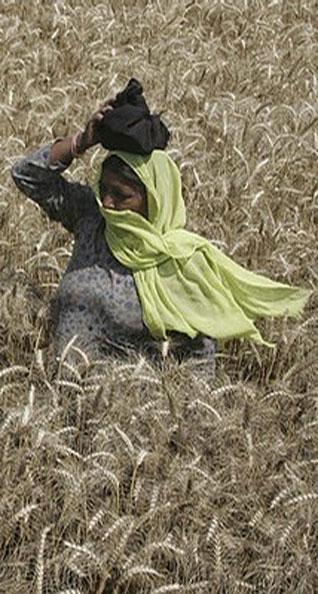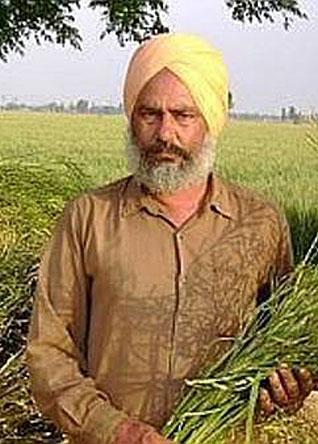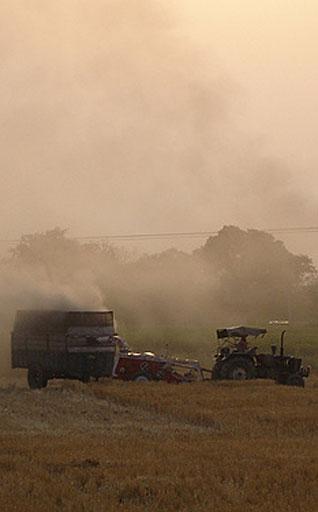History
Punjab: Bread Basket to a Nation
by HARI SUD
Punjab is India's granary - there is no other granary like it anywhere in the world.
A small area in the northwest [greatly diminished from the original land by the Partition of India in 1947 and subsequent bifurcations by the Indian government], bordering Pakistan in the west and Haryana state to the south, it is now irrigated by three of the five great Punjab rivers, which flow out of the Himalayas and straight into its heartland.
The prosperous Punjabis can boast of no greater wealth than their sturdy people and the land's 30-feet-thick topsoil. In the crop year 2007-08, Punjab has produced 27 million tons of food grain on less than 1 million hectares of land, which is about 2 percent of India's total cultivable land.
Producing that much food is no mean feat; the state has contributed 10.3 million tons of wheat to the central wheat pool this year.
Power and irrigation dams built about half a century back have provided water and power to the farmers, allowing them to grow a mountain of food. Punjab's people are not only farmers, but are also businessmen, technocrats and administrators. They have also been stalwarts against foreign conquerors for over a millennium.
For many centuries, this land has been a battleground for all kinds of invaders from the West. Alexander arrived in Punjab in 325 BC, bent on the conquest of India, but he turned back when he and his soldiers found the going tough.
Muslim invaders arrived in the 11th century AD, resulting in 700 years of Moghul/Muslim rule in India. They made Punjab their second home and converted about half the population to their faith. British conquered this land in 1845 and settled down to rule for another 100 years.
Unfortunately for the Punjabis, the people who had converted to the Muslim faith separated from greater Punjab in 1947, along with their land. It was an unprecedented upheaval.
The present Punjab is a shadow of its original glory.
But, despite its upheavals, it is prosperous; it is restive for progress and determined not to let in any more invaders.
Punjab in India is an area less than half the U.S. state of Kansas, and is home to 27 million people. A majority, made up of Sikhs and many of the other religions, follow the Sikh faith of Guru Nanak, a 16th century saint/poet/philosopher who rejected the prevailing Hindu philosophy and practices. Nine other Gurus further shaped the nascent community. The last of them, Guru Gobind Singh, reiterated in its followers a spirit of self-sacrifice and active resistance to tyranny. At that time, the people of Punjab faced a number of tyrant rulers, both Hindu and Muslim.
After 1947, the people of India's Punjab inherited a lackluster land, a very deficient irrigation system, an old feudal land ownership system and six million refugees. To make it worse, there were no communication systems of any kind in the state, except to serve the interests of the British government. The British had purposefully spent money to build agriculture and irrigation systems in the western (now Pakistani) half of Punjab, none in the other half.
For Punjab on the Indian side, everything had to be built anew.
Today, Punjab's agricultural statistics are mindboggling. What the Punjabis have done in 60 years is homage to their spirit and hard work.
Land reforms were initiated in 1954. The Bhakhra and Ponga Dams, built to harness the rivers Sutlej and Beas, were completed in 1960 and 1966. Other major irrigation projects and flood control infrastructure were continuously built or upgraded over the last 40 years. As a matter of fact, U.S. agronomist Norman Borlaug initiated his Green Revolution in Punjab in the early 1960s. Other Indian states followed Punjab's lead, but with lesser success.
To be fair, there are other states in India that are contributing equally to the country's growing prosperity. But, Uttar Pradesh, for example, has four times as much land as Punjab and four times the population.
How did the Punjabis accomplish what they have done?
Hard work is first and foremost, catapulting Punjab into a breadbasket. But Punjabi farmers' adaptability to new technology and new ideas is a key element of the exponential rise in grain production.
Tilling the land with tractors on a large scale began in 1954, improved seeds arrived in 1958-62, the use of synthetic fertilizers became widespread in 1960 and the use of pesticides began in earnest in the 1970s. All along, the government stood by with electricity, training, research and a distribution system. No matter how faulty the distribution system appears today, it manages to cope with the mountain of food that arrives in April every year.
It is heartening to hear that farmers in Punjab are achieving wheat output per acre which is comparable to the output in Kansas, where mechanized corporate farming has been established for over a century.
Conditions in Punjab are much hotter. Subsoil moisture, which sustains crops, stays high in the United States. Harsh hot weather in fall, summer and spring dries crops quickly if they are not irrigated. Hence, a lot of attention is paid to getting water to the fields during the dry season.
If there is a serious failure on the agricultural front in India, it is not because of the lack of hard work and crop-sustaining input in its bread-basket, Punjab, but the debt trap that medium and small-scale farmers find themselves in.
The main problem is the minimum support price - the price at which the government purchases wheat or rice for its central pool.
Private trading is forbidden during government purchases. This price is set low - for example, for wheat this year, it is Rs. 1000 per quintal (US$28 per 100 kilograms). In private trade, a farmer could fetch as much as Rs. 1600 (US$37).
The Indian government argues that since it provides most of the input to the farms free of cost, its procurement price should be low. This is not acceptable to farmers, however.
Unfortunately all this progress in Punjab has come about at the high cost of depleting groundwater. It is a serious problem. Too much water has been pumped out of the ground aquifers, and soon they will run dry, leaving the farmers with nowhere to turn. Alarm bells are already ringing. Governments have banned any more tube-wells in specific areas. As long as existing tube-wells are running full tilt, they will pump out the pure water to the fields, creating a bigger problem a generation later.
In summary, the agricultural wonders achieved by the people of Punjab on very little land have sustained the granary of India. All this progress in agriculture has allowed India to feed itself for the last 30 years.
[This article is adapted from a piece by Hari Sud, a retired vice president of C-I-L Inc., a former investment strategies analyst and international relations manager. A graduate of Punjab University and the University of Missouri, he has lived in Canada for the past 34 years.]
June 28, 2008
Conversation about this article
1: Harinder (Shimla, India), June 29, 2008, 8:48 AM.
Kudos to the hard working and sturdy Punjabi farmers. We Sikhs are all proud of them. But this will last as long as the Sikh tills the land himself and does not outsource it as their cousins in West Punjab did with disastrous consequences in 1947. The most salient philosphy of life is "Kirat". "Raj karega Khalsa" has a causality relationship with "Kirat". They do Raj who do Kirat! See Obama, Mayawati, Laloo Yadav. All people of these races have done Kirat. Unfortunately one see in Punjab today this singular quality which made us shine world wide till now is gradually going in disrepute for unknown reasons. Our gurdwaras must highlight the life-giving and life-sustaining quality of "Kirat". Most Sikhs I see in India today are divorced from Kirat. They are mostly middle class following the life style of traditional Banias. This has dangerous consequence for the well-being of our people.
2: H. Singh (U.S.A.), June 30, 2008, 6:34 PM.
It is very important that when we talk about Punjab and its economy, in particular, agriculture, we need to understand how Punjab's resources are controlled by the outsider entities: minimum price policy and control over river waters are the first ones to name. The writer should have highlighted the water theft by Haryana and Rajasthan and how it is contributing to the depleting water table in Punjab, which in turn is affecting the hydrology of Punjab. Now, Punjab is considered a breadbasket not only to India but to Pakistan also. Secondly it was not the partition of India in 1947 BUT the partition of Punjab. Lastly, it is not the Indian government that is responsible for giving free electricity but the Punjab government to its farmers. The Indian government on the other side takes free electricity from Punjab's resource waters and channels it to itself. The Punjab government has to produce its own electricity from coal power. The control over river waters by an invasive entity such as BBMB and the Indian Government's policies of minimum price contribute to the economic genocide of Punjab. Its seems that we are more interested in reading about the fantasy of Punjab rather than bravely accept the facts.
3: Kanwal Nain Singh (Lindsay, Ontario, Canada), July 01, 2008, 10:00 AM.
Mr. Sud's writing is very revealing about the hardships and handicaps under which the farmer community in Panjab has endured, and yet have been proud producers to be called the Bread Basket of India. Only thing which I would like to point out is that Punjab was not bifurcated only in 1947. It was subsequently divided to create a separate state of Haryana, and further divided again to merge large territory to create Himachal Pardesh. The present State of Punjab is not even one fourth of pre-partition Panjab. These were not economic decisions but political, designed solely only to weaken the growing strength of Panjab vis-a-vis other states in India.
4: Hari Sud (Toronto, Canada), July 29, 2008, 8:39 AM.
The author wishes to thank all readers of this paper. Inspite of all the issues listed above by readers, the author disagrees with them. If free market economy has to prevail, then the input costs will go up as these will have to be priced at market rate. That will increase the production costs. Sure, Rs 1600/- a quintal is a good price, but not good enough. However, the Punjabi farmer has to be complimented for his/her hard work and the prosperity in Punjab. Punjab in itself has no water resources of its own except rainfall and flood water. All rivers flow into it from the north. Punjabis have advantage of them. It is very good for Punjab. Punjab's trifurcation did not do the damage. The lowly developed areas of Himachal Pradesh and Haryana were taken out in 1965; only the prosperous part with great river projects were left for Punjab to enjoy. Only damage which happened to Punjab was bifurcation in 1947 was that it lost its soul. In addition - river disputes began.
5: Terry Brown (U.S.A.), October 04, 2008, 12:31 PM.
Many thanks to the writers of this article and its commentators from an ignorant American who is just beginning to learn about India. Could "Harindar" please be so kind as to instruct a foreigner regarding the philosophies of "Raj" and "Kirat" mentioned in his note? I would also be most interested as to further discussion about the importance of the 1966 trifurcation, which seems to be regarded with different significance by some of the commentators. Again, many thanks.






